
SAG-AFTRA, UAW, Amazon, and More: 3 Hiring Takeaways from Today’s High-Profile Strikes
Labor issues have upended how employers and workers alike currently view the job market. In particular, high-profile strikes throughout the United States brought fair compensation, workers’ expanding expectations for flexible workspaces, and the role of Artificial Intelligence (AI) in the workplace into the news cycle.
But workforce upheaval doesn’t have to upend a smart approach to hiring. In fact, a deft, data-informed view of the landscape can help recruit new workers and retain a satisfied workforce. It may even make it easier for management to work with organized labor.
To learn more about how, read on.
#1: Workers Expect More Competitive Wages
Setting competitive salary ranges is always key to successful recruitment. Of course, it doesn’t take a strike to highlight how an enterprise employer like, say, Amazon has the resources to pay workers more than a local tech startup.
That said, the recent strikes have further underscored what workers view as a competitive wage. And the passage of wage transparency laws has compelled many employers across the country to include salary ranges in job listings. Used right, this salary data can offer you a leg up on the competition.
That’s why our business intelligence product, Job Market Pulse (JMP), makes it easy to access current and historical salary data. With an easily navigable dashboard, you can aggregate nationwide and regional wages and benefits in your specific industry. You can even use JMP’s Wage Benchmarking Tool to dive into specific competitors’ salary ranges – and see how your salaries compare.
Then, empowered with JMP data, you can identify the differences between what you and your competitors tend to offer. Balanced with data about ancillary benefits, bonuses, and perks (even ones as particular as commute times), you can craft a more competitive compensation package. And as workers today are increasingly concerned with how their benefits complement their financial compensation, that may make all the difference.
Which brings us to our second takeaway…
#2: Today’s Workers Want More Flexibility
As we touched on above, workers today focus on more than financial compensation. Those non-wage-based concerns have been at the center of recent strikes.
The United Auto Workers (UAW), for example, leaned hard into the promise of a four-day workweek. And from manufacturing to knowledge work, such flexibility is a perk employees – and even some employers – are increasingly willing to embrace.
Your own strategy for how to address greater demands for flexible work should be developed with your business goals in mind. Then, balanced with a 360-degree view of current market trends, you’ll be better positioned to attract, recruit, and (crucially) retain satisfied talent.
Say, for example, that you want to see how many employers in your area include perks like “remote work” or “unlimited PTO” in their listings. On the one hand, studies show the opportunity for remote work is the most sought after non-financial benefit. On the other hand, the same study suggests unlimited PTO may not be as significant a draw for potential employees.
With these facts at the ready, you can use JMP to further understand whether your competitors are putting this information into action. Then, you can offer incentives that highlight the strengths of your workplace and distinguish you from other potential employers.
#3: Artificial Intelligence Is Changing the Workplace
The rise of AI is changing the workplace. In fact, concern about the role of AI was a central reason behind the SAG-AFTRA strike. And research from Pew shows over 60 percent of US workers believe the technology will significantly impact the workplace over the next two decades.
Some forecasters view the future of work as AI-enhanced. Others think AI will drive employers to hire for skills and competencies rather than credentials. And though AI-focused jobs are increasing, demand at even the most public AI firm has been relatively measured (Figure 1).

Figure 1: OpenAI has exhibited continued growth since introducing their product. Still, they aren’t yet at the level of tech giants like Google and Amazon.
The workforces at OpenAI and their competitors haven’t yet reached their peak. Side note: in OpenAI’s case, the turmoil around CEO Sam Altman’s departure – and subsequent rehiring – could be why we see so many vacancy fluctuations around that time. (For context, Altman was first fired by OpenAI on November 18th.) But competitive intelligence offers you another opportunity – beyond showing the potential impacts of C-Suite turnover.
With JMP’s historical salary data, for example, you can track the presence of “AI” in competitors’ job listings. You can even set up alerts that offer a consistent view of this data and help you better understand how companies approach hiring for AI-specific roles, the types of roles increasingly dependent on AI-related skills, and the prevalence of AI in the job market overall.
Say, for example, you set up a notification that alerts you when job postings mentioning AI reach a certain threshold. Or maybe you have an eye on the debate about potential AI regulations, and want to identify job trends that index to news about new governmental guidance.
With JMP’s customized alerts, you can turn your attention to critical, time-sensitive tasks such as client deadlines. But when the job market changes or a trend begins to emerge, you won’t miss a beat.
Quality Compensation Data Helps Satisfy Worker Expectations
Quality data drives quality decisions. What’s more: it helps ensure you’re crafting a compensation package – and a quality workplace experience overall – to attract and retain a better workforce.
The fact is, the job market rarely supports smooth sailing. But with the right guide (hint: it’s in the data), you can be sure you weather whatever upheaval starts to swell. Interested in learning more about how to make jobs data more easily navigable for your business? Reach out!